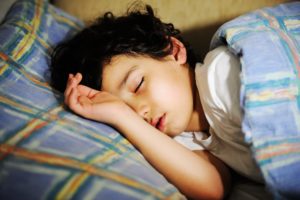When you buy through our links, we may earn a commission. Products or services may be offered by an affiliated entity. Learn more.
Sleep-Onset Association Disorder
Healthy sleep habits start in childhood . Sleep supports a child’s development and allows them to have the daytime energy they need to thrive. Many caregivers want to do everything in their power to help their child sleep soundly. But, in some cases, the more a parent intervenes, the harder it is for a child to fall asleep on their own.
Understanding behavioral sleep problems can help caregivers learn to set healthy limits and nurture positive sleep habits. We take a closer look at sleep-onset association disorder, including tips for parents and when to talk with a pediatrician.
What Is Sleep-Onset Association Disorder?
Sleep-onset associations are a common cause of chronic insomnia in children. Around 20% to 30% of children experience difficulties falling and staying asleep and, in most cases, these issues are related to a child’s behavior rather than an underlying medical condition. Resistance to bedtime, difficulty falling asleep, and waking up during the night are often caused by sleep-onset associations or challenges in setting and maintaining bedtime rules.
A child who experiences insomnia due to sleep-onset associations can only fall asleep under certain conditions. These children require a specific action by the caregiver to fall asleep in the evening or after waking up during the night. Over time, a child may begin to associate a specific routine with falling asleep and become unable or unwilling to go to sleep unless their caregiver intervenes.
Children can develop sleep-onset associations related to a specific object, setting, or activity. Examples of sleep-onset associations that a child may begin to rely on include:
- Feeding
- Rocking
- Keeping bedroom lights on
- Watching television
- Music
- A caregiver’s bed
- Being in the same room as a caregiver
Sleep-onset associations are common in children and often resolve on their own as a child develops. When sleep-onset associations become persistent, challenging, and cause the child to lose sleep, they may be diagnosed with sleep-onset association disorder.
Although behavioral insomnia is most common in infants and children up to 5 years old, symptoms can continue into adolescence or adulthood. In adults, insomnia related to sleep-onset associations can make it difficult to fall asleep without specific conditions, like keeping the lights on or having noise from a television.
Help Your Child Sleep Better With Pediatric Sleep Coaching

our partner at sleepdoctor.com
Learn More“Life-changing! My anxiety about my son’s sleeping habits were immediately reduced after talking to Sara. She went above and beyond to tailor a schedule to our goals, answer our questions, keep us on track, and check in to encourage us when we just thought we couldn’t do it anymore.”
Rachael B. – Verified Customer
Symptoms
Chronic insomnia in children caused by sleep associations often includes three primary symptoms.
- Opposition to bedtime: Children with sleep-onset associations may try to delay their bedtime or resist being placed in a crib or bed while still awake unless specific conditions are met by caregivers.
- Trouble falling asleep: Sleep-onset associations can make it difficult for children to fall asleep on their own without specific caregiver actions. Children may express fears or anxiety about going to sleep without these conditions being met.
- Lengthy nighttime wakings: If a child with strong sleep associations wakes up during the night, they may be unable to self-soothe and fall back to sleep unassisted. Children may cry or go to their parent’s bedroom to get help meeting the conditions they need to go back to sleep.
Like other sleep issues in childhood, sleep-onset associations can lead to poor sleep and daytime sleepiness. A child with inadequate sleep may also be irritable during the day, experience hyperactivity, have trouble focusing, and exhibit defiant behavior.
Causes
Sleep-onset association disorder is a type of behavioral insomnia. This means the cause is related to a set of learned behaviors. In sleep-onset association disorder, a child becomes accustomed to certain conditions when falling asleep. Because the child has learned to associate sleep with these conditions, they have trouble falling asleep if the conditions are not met.
The specific conditions needed to fall asleep depend on the child’s established bedtime routine. Factors related to the child’s home environment, like sharing a bedroom, living with extended family, and close living quarters, may also contribute to the development of sleep-onset associations.
Diagnosis
Diagnosing sleep issues in children starts with an evaluation by a child’s doctor or pediatrician. To better understand the child’s symptoms, the doctor will ask questions about the child’s sleep and may use a screening tool, like the BEARS survey, to collect information related to:
- Bedtime issues
- Excessive daytime sleepiness
- Awakenings during the night
- Regularity and duration of sleep
- Snoring
To get an accurate understanding of the child’s sleep issues, the doctor will want specific details from the caregiver. This may include the child’s sleep schedule, bedroom environment, nightly routine, and how the caregiver responds to the child’s sleep issues. For children having trouble falling asleep, these details can help determine whether the cause is behavioral or if there could be an underlying medical condition.
The pediatrician may also ask the caregiver to keep a detailed sleep diary. A sleep diary for a child should contain important information about their sleep-wake pattern, including:
- Scheduled bedtime and actual time of sleep onset
- Times of any nighttime awakenings and morning rise time
- Sleep quality
- Naps
- Eating patterns
- Level of sleepiness during the day
- Medical, behavioral, and other daily events
Treatments
For sleep-onset association disorder and other behavioral insomnias, prevention is the most effective treatment. With help from a doctor or pediatrician, parents can begin teaching children good sleep habits from the early days of infancy.
Healthy sleep habits for infants includes a regular feeding and nap schedule, a consistent bedtime routine, and placing the baby in their crib sleepy but still awake. These practices can help an infant learn how to fall asleep on their own.
Effective treatments are available for children with symptoms of chronic insomnia due to sleep-onset associations. In fact, behavioral changes are the cornerstone of treatment for behavioral insomnia of childhood. A child’s doctor may recommend one or more evidence-based techniques for addressing behavioral insomnias.
- Bedtime routines: A consistent bedtime routine is one of the most effective tools for treating behavioral insomnias in children. A good bedtime routine consists of 20 to 45 minutes of relaxing activities such as taking a bath, putting on nightclothes, and reading a bedtime story.
- Systematic ignoring: This type of sleep training involves rapidly or gradually removing the underlying sleep association. There are several ways of applying systematic ignoring, so parents should speak with a pediatrician to develop a plan of action that takes into account the family’s needs and sleep goals.
- Bedtime fading: Bedtime fading addresses imbalances between the child’s ideal bedtime and when they are used to falling asleep. The technique involves initially scheduling the child’s bedtime to when they naturally fall asleep and then slowly shifting their bedtime earlier each night. Eventually, the child should be able to fall asleep at their regularly scheduled bedtime.
- Strategic napping: Infants and young children need a lot of sleep and naps are an important tool for children who are not ready to sleep through the night. Parents should think about how daytime napping may affect their child’s nighttime sleep. Avoid naps too close to bedtime and try to keep naps short later in the day or in the early evening.
- Positive reinforcement: For slightly older children, caregivers can consider developing a system of goals and rewards to reinforce good bedtime habits and behaviors. Keep the goals small and achievable to set the child up for success before creating more challenging goals.
Behavioral changes are usually the first-line treatment and can be highly effective. However, every child is different. If a child does not respond to behavioral techniques, their doctor may refer them to a sleep specialist who can provide more targeted treatments.
Tips for Parents
Sleep-onset associations can take a toll on caregivers. Fortunately, experts have developed behavioral interventions that are effective in the majority of children. To cope with the challenges of insomnia, caregivers may benefit from keeping several tips in mind.
- Find resources: Parents may find it helpful to educate themselves about the fundamentals of sleep. They can speak with a pediatrician or sleep specialist for guidance and resources about healthy sleep routines and behaviors.
- Be consistent: Behavioral changes and routines require consistency to take hold. After creating a plan of action, parents should stick to it. Consistency helps reinforce new, healthy patterns and habits around sleep.
- Be loving but firm: When introducing something new to a child’s routine, they are likely to protest. Strong pushback is normal and represents the first step to creating better sleep habits.
- Self-care: It is important for caregivers to tend to their own needs while dealing with a child’s sleep issues. Caregivers may benefit from finding time for enjoyable activities , connecting with other parents, and asking for extra help when they need it.
When to Talk to Your Pediatrician
Caregivers should contact a pediatrician if they have concerns about their child’s sleep or need support in developing healthy habits. A pediatrician can provide education to help caregivers determine the right bedtime, develop a nightly routine, and learn ways to set healthy limits on a child’s behavior.
Pediatricians can also provide a referral to a pediatric sleep clinic or sleep specialist if behavioral changes are not sufficient to address a child’s sleep issues. In some cases, a sleep study may be required. Fortunately, sleep issues in children are usually temporary and may resolve without additional treatment.

Still have questions? Ask our community!
Join our Sleep Care Community — a trusted hub of sleep health professionals, product specialists, and people just like you. Whether you need expert sleep advice for your insomnia or you’re searching for the perfect mattress, we’ve got you covered. Get personalized guidance from the experts who know sleep best.
References
9 Sources
-
A.D.A.M. Medical Encyclopedia. (2020, October 2). Bedtime habits for infants and children. MedlinePlus., Retrieved May 9, 2022, from
https://medlineplus.gov/ency/article/002392.htm -
Tapia, I. E. & Wise, M. S. (2022, April 15). Assessment of sleep disorders in children. In R. D. Chervin (Ed.). UpToDate., Retrieved April 26, 2022, from
https://www.uptodate.com/contents/assessment-of-sleep-disorders-in-children -
Owens, J. A. (2020, August 18). Behavioral sleep problems in children. In R. D. Chervin (Ed.). UpToDate., Retrieved April 26, 2022, from
https://www.uptodate.com/contents/behavioral-sleep-problems-in-children -
Carter, K. A., Hathaway, N. E., & Lettieri, C. F. (2014). Common sleep disorders in children. American Family Physician, 89(5), 368–77.
https://pubmed.ncbi.nlm.nih.gov/24695508/ -
American Academy of Sleep Medicine. (2014). The International Classification of Sleep Disorders – Third Edition (ICSD-3). Darien, IL.
https://aasm.org/ -
Karna, B. & Gupta, V. (2021, November 20). Sleep disorder. In StatPearls. StatPearls Publishing., Retrieved April 26, 2022, from
https://www.ncbi.nlm.nih.gov/books/NBK560720/ -
Paruthi, S., Brooks, L. J., D’Ambrosio, C., Hall, W. A., Kotagal, S., Lloyd, R. M., Malow, B. A., Maski, K., Nichols, C., Quan, S. F., Rosen, C. L., Troester, M. M., & Wise, M. S. (2016). Recommended amount of sleep for pediatric populations: A consensus statement of the American Academy of Sleep Medicine. Journal of Clinical Sleep Medicine, 12(6), 785–786.
https://pubmed.ncbi.nlm.nih.gov/27250809/ -
National Institute of Child Health and Human Development. (2019, August 12). Moms’ mental health matters., Retrieved May 9, 2022, from
https://www.nichd.nih.gov/ncmhep/initiatives/moms-mental-health-matters/moms -
Sulkes, S. B. (2021, August). Sleep problems in children. Merck Manual Professional Version., Retrieved April 26, 2022, from
https://www.merckmanuals.com/professional/pediatrics/behavioral-concerns-and-problems-in-children/sleep-problems-in-children



















